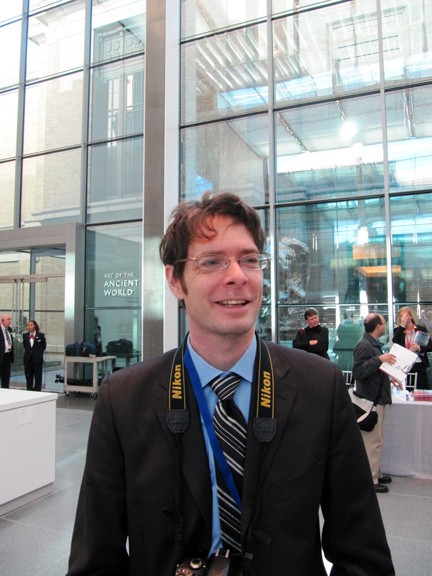Phoenix Critic Greg Cook; Two
Museums and Local Artists
By: Greg Cook and Charles Giuliano - Jan 31, 2011
Charles Giuliano Museums make little or no effort to court lower tier writers such as myself. They see no direct line between our reviews and attendance. Museums don’t like getting tough reviews. Particularly here in the Berkshires museums and galleries are used to puff pieces.
Last winter, we attended the Boldini opening at the Clark Art Institute. There were some interesting flashy aspects to the work but for the most part I found it turgid. It entailed everything about academic art that inspired the impressionist revolution. Sebastian Smee of the Globe came and gushed over it. After that, there was little to add. Since I had nothing good to say, I opted to say nothing at all. I feel the same way about a Petah Coyne show at Mass MoCA. She is an artist that I found interesting a decade ago, but the show at Mass MoCA is overblown. The work doesn’t take me to new areas of surprise and wonder.
What happens a lot in contemporary art is that you track emerging artists who have interesting ideas. With success and status the work gets enlarged until it is out of proportion to its initial intensity.
A random case in point might be Ellen Gallagher. There was a lot of interest and excitement about the work when she first showed with Mario Diacono, a respected Boston gallerist. As she ascended the food chain, the work became flaccid. I really hated it by the time she got to Gagosian where her work is currently on view. Perhaps it is unfair to focus on a single artist, but it is emblematic of the phenomenon. Matthew Richie and Matthew Barney would be examples of artists whose work I find to be utterly pretentious.
The Situationist Guy Debord wrote about the art of the spectacle. We now live in the age of the spectacle.
Let’s return to your point about functioning like a small town paper and shaping local opinion. All art is political: at least art that is vital and worthy of critical speculation. There is a lot of pretty art that is of no interest to me. There is no point even discussing it.
What Mass MoCA and Tanglewood opt to exhibit or program has an enormous social/ political/ economic impact. They, and other arts organizations to a lesser degree, drive the industry of cultural tourism that directly impacts hospitality/ restaurants and jobs. So their decisions are aesthetic but have broader impact. They constantly consider audience appeal. That provides checks and balances to their risk taking. A component of that can result in appealing but enervating art.
For Tanglewood that may be programming Garrison Keillor year after year. Surely there are good audience and economic reasons to do that. But what a bore. For Mass MoCA it was exemplified by a show of celebrity photographs by Leonard Nimoy. Throngs came looking for the pointy ears. The work is professional and credible but is it worthy of the status of Mass MoCA? Are you a nay sayer to point that out? Of course the show got lots of celebrity coverage, so what difference does it make to dissent?
Greg Cook: I don’t mind museums selling out—or being entertaining—or whatever, as long as that’s not all they are. Everyone needs to bring in money to keep the doors open, and to subsidize the more eccentric or unusual or unexpected or challenging or whatever-you-want-to-call-it stuff.
Actually sometimes this spectacle is my favorite stuff, because for once the museum is letting itself and its audience have fun. So much contemporary art at top institutions is like dreary homework. But, of course, spectacle can simply be sweet nothings. Entertainments should be smart too—in the tradition of Graham Greene’s “entertainments” versus his “serious” novels.
I’ve not seen the reviews you mention, but in general I don’t have a problem with a writer complaining that a theater downplayed the gay aspects of a play. However I do find it unfair to focus on the artists’ or performers’ private lives. Stick to the public stuff—the art, the venues, the community. But any content of the show is fair game. Fairness is the watchword. I don’t mean nice or unbiased, but fair, just. Then the danger, as you note, is more about shoehorning your personal issues into the art at hand, or falling into a shtick. But that danger seems to be about your writing becoming boring and predictable and simplistic. I mean, art is one of the few places in our society built for playing with and discussing the issues of our time. Bring it on.
Giuliano: In a Phoenix article, you discussed issues regarding the Foster Prize at the ICA and the now long lapsed Maud Morgan Prize at the MFA. You framed the argument with a focus on the manner in which Boston artists are ghettoized into these ancillary and regional programs. The are isolated from the mainstream of museum programming. This seems to be a power point for your overview of the provincial nature of Boston art. Can you expand on this, and why the Foster and Morgan prizes demean rather than enhance the work of an entire community of artists?
Cook: Local ghetto shows aren’t a prori demeaning. For example, the Museum of Modern Art’s “Abstract Expressionist New York” or “Greater New York” at MoMA’s PS1 don’t become bad because of their local focus—though they may be bad anyway. The problem is when local art ghetto shows become practically the only time museums show local art. Or worse, in the MFA’s case, when a local ghetto show like the Maud Morgan Prize is one of the rare times they show local art—and then they neglect to even operate it since 2006.
That quarantining of local art is a symptom of an overall lack of vision. Which is partly rooted in the I’m-better-than-Boston attitude among our curators. Of course, that attitude is pervasive among our critics and artists too. Considering how popular it is you’d think somehow all our I’m-better-than-Boston folks could get their awesome selves together and actually make the Boston art scene better. Instead local art ghetto shows often become one way local curators say, “We don’t dare mix this local crap with the good stuff.”
Too many of our curators are followers, bringing us nice productions of stuff they’ve seen done (bigger and better) elsewhere, not leaders. One of the surest ways to do what everyone else is doing is to just show artists already on the Circuit of international art fairs and biennials and Chelsea, New York. One of the easiest ways to be a trailblazer is to show art from off that circuit. But who has the guts?
Perhaps museum curators these days don’t know how to deal with stuff that hasn’t already been preapproved by, say, Artforum. Since little out of Boston gets national exposure, Boston curators assembling shows of local art are suddenly without their usual bearings. That’s the exciting risk of the shows, but maybe it freezes curators.
At the ICA, the impulse seems to be to “professionalize” local work—like a mom combing a kid’s hair to make her/him presentable in public. Or it feels like curators pick local art that resembles what they see in Artforum, or push artists to move in that direction, because that’s what they’re confident is “good.” That neatening-up tendency is what I hear between the lines when ICA Director Jill Medvedow tells the press that the show offers local artists “experiences that they might not have had before, which is getting to work with museum curators.” When Medvedow got the job in 1998, the Globe reported: “And what about the always-touchy subject of showing Boston-based artists? Medvedow certainly doesn't rule that out, but says ‘there are other ways to involve them, like having them give tours of exhibitions from their own perspectives.’”
This “professionalizing” tendency may be why I find a good number of the artists in the Foster Prize shows interesting, but their appearances in the show unflattering. The ICA’s architecture doesn’t help. The new building is scaled to supersized international Circuit art (though their freight elevator accidentally wasn’t quite). But the majority of artists not already on that circuit don’t work at that scale, can’t afford to, and so the oversized building can unfairly make their art—and their ideas—seem puny.
There are models of the local ghetto show done well, like last winter’s 2010 DeCordova Biennial, which was organized by assistant curator Dina Deitsch. The show was interesting, witty, varied in ages and styles, ranging from visionary art to absurdist conceptual happenings. I loved some of it and hated some of it. Which is exactly as it should be. And it had art you left the museum wanting to talk about.




